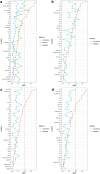Transthoracic echocardiography and mortality in sepsis-associated acute kidney injury: An analysis based on MIMC-IV database
- PMID: 40652011
- PMCID: PMC12255731
- DOI: 10.1038/s41598-025-10776-7
Transthoracic echocardiography and mortality in sepsis-associated acute kidney injury: An analysis based on MIMC-IV database
Abstract
Transthoracic echocardiography (TTE) has become an essential tool for hemodynamic evaluation. However, its effect on outcomes in sepsis-associated acute kidney injury (SA-AKI) remains unclear. This study aims to explore the association of TTE with the 28-day mortality in SA-AKI patients. MIMIC-IV database was used to identify patients with Sepsis whether they underwent TTE evaluation within 24 h of sepsis diagnosis. Propensity score matching (PSM) was employed to minimize confounding, and subgroup analyses were conducted to assess the impact of TTE across different AKI severity grades. Following PSM, 121 patients were included in each group (TTE vs. no TTE). The TTE group showed improved 28-day survival compared to the no TTE group (odds ratio = 0.80, 95% CI 0.21-0.81, p = 0.011). A subgroup analysis based on different AKI stages showed no significant association between TTE and the 28-day mortality in KIDGO stage 1 or 2 patients. However, for patients with KIDGO stage 3, those who underwent TTE evaluation had a significantly lower 28-day mortality rate (OR 0.81, 95% CI 0.68-0.96, p < 0.05). Patients with SA-AKI who underwent TTE had an improvement in 28-day mortality, with this effect being more pronounced in patients with KIDGO stage 3.
Keywords: Acute kidney injury; Echocardiography; Sepsis.
© 2025. The Author(s).
Conflict of interest statement
Declarations. Competing interests: The authors declare no competing interests. Ethics approval: This study is based on the publicly available MIMIC-IV database, which contains de-identified patient data in compliance with HIPAA regulations. Informed consent was obtained at the time of data collection, and the need for individual consent was waived for this retrospective analysis. Access to the database requires ethical training and approval, which the researchers have completed. Additionally, patients under 18 years old were excluded from this study.
Figures



References
-
- Hoste, E. A. J. et al. Global epidemiology and outcomes of acute kidney injury. Nat. Rev. Nephrol.14, 607–625. 10.1038/s41581-018-0052-0 (2018). - PubMed
MeSH terms
Grants and funding
LinkOut - more resources
Full Text Sources
Medical
Miscellaneous

